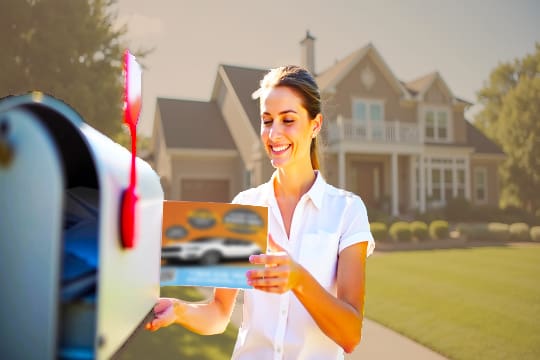Summary
Ready to cut through the digital noise and make a lasting impression? Postcards offer a powerful and tangible way to connect with your community, boasting response rates that often outperform digital ads. This isn't just junk mail; it's a proven strategy for local businesses to build trust and drive action.

Saturday – July 26, 2025
Postcards are a great way for local businesses to advertise. Unlike online ads that disappear quickly, postcards are physical things that people can hold onto and see again and again. This repeated exposure helps people remember the brand better. A colorful postcard in the mail is a nice change from all the digital ads we see, and it’s more likely to get noticed without feeling annoying. This makes postcards a valuable tool for businesses that want to make a lasting impression in their community.
“Postcard marketing is a great way for businesses to get new customers. It’s a smart choice because it gives you a lot back for what you spend and people are more likely to respond to postcards than other mail. Think about it: you don’t have to open a postcard to see the message. It’s right there in front of you. This is a big advantage. “
Key Benefits:
● You can hold it: Unlike an ad you scroll past online, you can physically touch a piece of mail, which makes it feel more real.
● It sticks in your mind: Seeing the same mailer in your house over and over helps you remember the message better than seeing an ad just once on your phone.
● It’s not lost in the noise: Your mailbox is a lot less crowded than your social media feed, so your message is more likely to be seen.
● It’s more interesting to look at: The feel of the paper and the design of the mailer can grab your attention and make you want to read it.
● It hits close to home: You can send a message directly to people in your own neighborhood, making it feel more personal.
The Numbers Speak Volumes:
Data on direct mail, including postcards, reveals compelling effectiveness, especially for localized efforts.
● High Response Rates: The Direct Marketing Association (DMA) reports average response rates for postcards sent to a house list (existing customers) of up to 5.1% with a 29% ROI. Even prospect lists average 3.4% with a 23% ROI, often outperforming digital channels. Some sources suggest direct mail response rates can be up to 9 times higher than email, paid search, or social media.
● Real Engagement: Over 80% of households open and read their mail, with consumers interacting with direct mail around 4 times per household. Nearly 70% find direct mail more personal than online communication.
● Millennial Involvement: 84% of millennials look through their mail, and 64% prefer scanning mail for useful information over email. An impressive 92% of millennials have made purchases influenced by direct mail.
● Driving Action: Over 60% of consumers take action due to direct mail, such as visiting a website, store, or purchasing. Combining direct mail with digital campaigns can boost response rates by 63%, website visits by 68%, and leads by 53%.
● Trust and Credibility: Over 80% of people trust direct mail marketing, perceiving it as trustworthy and credible compared to digital advertising.
Think of it this way: postcards are like a friendly “hello” from a local business, delivered right to your mailbox.
Unlike an email ad that can be quickly deleted, a physical postcard is something you hold in your hands. This makes it more memorable and personal. It can be a simple way for a Ministry or business to:
● Share a new sale or deal. Tell people about your church or non-profit.
● Announce a new item, service, bible study, or tell the local community of a need
● Just say “we’re here!” to the people who live nearby
Because they are sent to specific neighborhoods, postcards are an affordable way for businesses to reach the people who are most likely to become customers. It’s a smart use of their advertising money.
To know if their postcard campaign worked, businesses can use special coupons or codes on the postcards.
To measure effectiveness, businesses can incorporate trackable elements:
● QR Codes: Unique QR codes on postcards can direct recipients to specific website landing pages for easy tracking.
● Unique URLs: Dedicated web addresses exclusive to the postcard campaign allow website traffic monitoring from the mailer.
● Specific Offer Codes: Distinct promotional codes customers use during purchase directly link sales to the postcard campaign.
Using these methods to track your postcards helps you understand whether your marketing is effective.
| Feature | Postcard Advertising | Google/Meta Paid Advertising | SEO (Search Engine Optimization) |
| Targeting | Better target the people you’re trying to reach most | Broad to granular demographic, interest-based, behavioral | Organic reach based on keywords and website authority |
| Tangibility | Physical, can be held and displayed | Digital only | Digital only |
| Cost | Potentially lower cost per impression for local reach | Can be expensive, costs fluctuate based on competition | Digitally speaking, very cost effective |
| Reach | Limited by mailing list size and geography | Potentially vast, global reach | Dependent on search engine rankings |
| Control | High control over design, timing, and delivery | High control over ad creative, targeting, and budget | Gives businesses less direct control over their messaging. |
| Immediacy | Can be relatively quick to design and send | Can be launched quickly | Long-term strategy; results take time |
| Engagement | They can be easily ignored or thrown away | Active engagement (clicks, views) | Users actively searching for information |
Longevity | It can have a lasting visual impact if kept | Disappear once the time limit expires or the campaign’s budget is depleted. | Long-term visibility if rankings are maintained |
| Local Focus | Excellent for reaching local communities | Requires careful geographic targeting | Relies on local search terms and local SEO efforts |
| Building Trust | Touch can feel more personal and trustworthy | Can build trust through consistent branding and positive reviews | Builds trust through authority and relevance |
Conclusion
Although online marketing tools like social media, online ads, and SEO are powerful, they shouldn’t completely replace traditional marketing tools such as postcards. The best approach is to use both, which is known as a multi-channel strategy.
Think of digital marketing as a wide net, capturing a large audience and providing you with helpful information. A postcard, however, is a physical item that can stand out from all the digital clutter. By sending out a postcard that supports your online message, you can create a more personal and meaningful connection with people in your community.
Sources and related content
- The Science & Psychology of Direct Mail – Design Distributors – https://www.designdistributors.com/blog/the-science-psychology-of-direct-mail
- The Ultimate Guide to Print Marketing | Solo Printing – https://soloprinting.com/the-ultimate-guide-to-print-marketing/#:~:text=or less. (,DMA)
- Direct Mail Postcards Statistics | Resources – Excel Printing – https://www.excelprintmail.com/resources/direct-mail-postcard-stats-and-facts/
- Direct Mail Marketing ROI vs. Digital – PDC Graphics – https://www.pdcgraphics.com/blog/new-data-proves-direct-mail-marketing-roi-is-higher-than-digital-marketing-channels/
- 263 Direct Mail Statistics You Should Know in 2025 – https://www.postcardmania.com/blog/direct-mail-statistics/#:~:text=USPS (2021),JICMAIL (2020)
Together, We Can Do This!
Is your Ministry, non-profit, or business success at a plateau, or perhaps they haven’t even taken off yet?
Our digital marketing agency specializes in igniting growth and driving tangible results when progress seems stalled. Our dedicated team of seasoned digital professionals is ready to analyze your unique situation and implement effective strategies.
They have the expertise to navigate the online landscape and effectively connect you with your target audience. Let us use our experience to transform your digital presence into measurable success and increased supporters.
Please reach out to us today.


